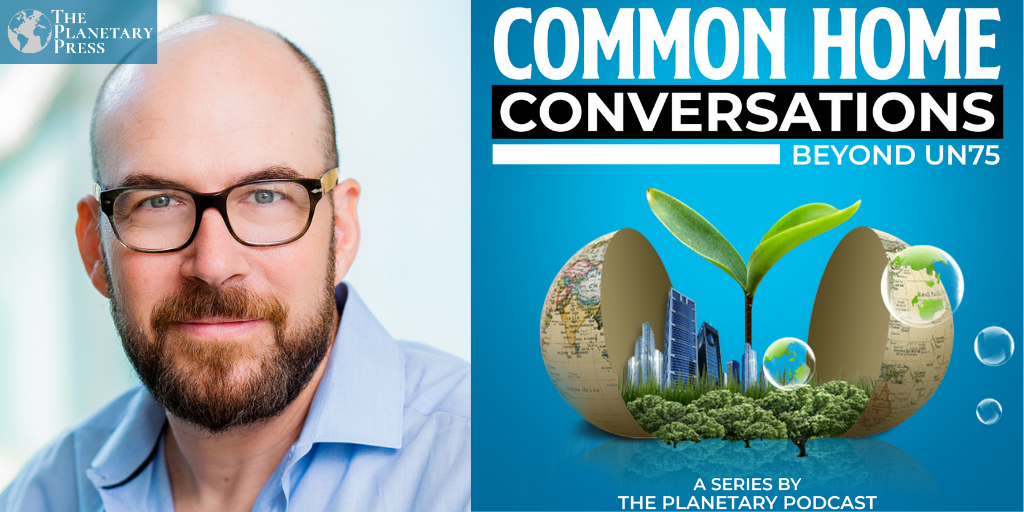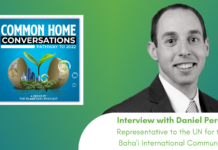Interview Transcript
Transcribed by Otter AI
Kimberly White
Hello and welcome to Common Home Conversations. Today we are joined by Karl Burkart, Co-Founder and Managing Director of One Earth. Thank you for joining us today, Karl.
Karl Burkart
Thanks. It’s great to be here talking to you.
Kimberly White
Can you tell us more about One Earth and the focus of your work there?
Karl Burkart
Yeah, I’m the managing director of One Earth, and we are a philanthropic initiative, particularly focused on the science policy interface for the three Rio conventions. And we are running correspondingly roughly three major scientific models that we support with leading scientists around the world contributing to those three models. The first big one is the climate energy transition model, which was published last year in a very dense 500-page book called achieving the Paris Climate Agreement goals. It was authored by 17 leading climate energy scientists and is now being widely cited. And that was really to look at how we can stay below the 1.5°C threshold of global temperature rise? The second one, the second model, is called the Global Safety Net, which was just published on Friday and Science Advances. That was a two and a half year plus effort, a very large spatial analysis—the first global scale analysis of biologically important land. And one of the component products coming out of it is, you could say, a set of recommended area-based targets for the upcoming UN Biodiversity Convention. So that’s the second Rio convention. It shows the different types of land that can contribute to ecosystem services and biodiversity by country. The third one, which we’re just starting in partnership with the University of Minnesota and other scientists will be involved in, is a global food security model. The third model will contribute to looking at how we feed 10 billion people sustainably on the planet.
Kimberly White
So, today we seem to have gone from climate deniers to an attitude of it’s already too late. Do you think we have the science and technology available today to form the solutions to stabilize the climate and keep warming at 1.5 degrees?
Karl Burkart
Yes, I, I love this question. Because the answer is absolutely, yes, we have the technology. And it’s not just the technology solved, and sort of we need to now go into production. It’s like we have the technology. It’s as Obama would have said shovel ready, you know, we have it sitting on the shelves. And in the climate model in the energy transition model we supported, according to that model, we need to go from about 20% renewable energy today to about 56%, globally, which varies by region by 2030.
So as you know, this is relatively straightforward. We know exactly how to do it. And it’s using technologies that are now battle-tested for ten or more years and are scaling quickly and becoming cheaper by the minute. So really, it’s not the technology that’s missing for the energy transition; it’s the dollars. And in the climate model, we have, well, the back of the envelope summary budget required for this. The transition I just mentioned is about 1.3 trillion a year roughly. And that’s less than one third what the governments spend today subsidizing fossil fuels, which are causing global warming. So, for less than a third of what we’re paying to destroy the planet, we could transition the energy with technology, create tons of jobs, be great for the economy. It would increase energy security as well. And it would reduce the health risks associated with fossil fuels and climate change. So it’s win-win isn’t the right word. It’s like win-win-win-win-win. It’s like five wins if we did that, and yeah, it’s just a matter of real political will at this point in moving the dollars.
Kimberly White
So governments have been creating commitments and new targets to combat climate change, while at the same time, as you just said, propping up the fossil fuel industry with trillions of dollars in subsidies, adding to the climate crisis. Do you think the COVID-19 economic recovery efforts are an opportunity to shift away from business as usual and toward cleaner, greener energy?
Karl Burkart
Yeah, I would say it’s not just yes definitely. And not just on the energy side, but also the nature based solutions side. I’m seeing a lot coming from governments, especially the EU, who have been a big leader in this, and they’ve announced several Commissions on sort of a green recovery. So I think that it did, COVID did two things. One thing it did, which, of course, has positive-negative, it slammed the brakes on the global economy. It was like you’re driving in your car, and a kid runs in front of you, and you have to slam on your brakes in a full stop. And that happens. So it’s sort of like all these conversations that were happening, and there was going to be a climate convention, there’s going to be a biodiversity convention, there’s going to be a big UN summit, all these things, just everything went on hold. And the results are kind of coming in now. We’ll see what happens, anywhere from 9 % to 17% reduction in carbon emissions this year. We have to wait, obviously, for the post mortem, but we think it’ll probably be somewhere in the middle, like maybe 12-13% of a reduction in greenhouse gas emissions, which is actually more than what we needed to do in terms of being on the 1.5°C track. So slamming on the brakes got us on the 1.5°C course. Now, the question is, are we going to just slam on the gas pedal? And I mean, that literally, right? Because we also have to make our transportation system much cleaner. But yeah, and I think that that slamming on the brakes gave us this pause. And a lot of people to kind of get started getting their ducks in a row, starting to look at recovery packages that could then be targeted towards sustainable and green infrastructure, energy and nature based solutions. The other thing that I saw with COVID is that just the awareness of nature, you know, how important nature is. Nature has always been hard to sell as a serious issue because somehow, climate change just sounded more technical. It was very technical and serious, and many technical and serious people started 20 years ago working on the climate convention.
For some reason, the biodiversity convention was left really playing second fiddle in another room. And you had your sort of hippie organizations fighting for nature, but was like the sort of technical serious people didn’t really get it. And I think COVID made a lot of people realize what happens when you start to unravel the natural infrastructure that is providing the ecosystem services that the entire planet requires to exist. You know, when you lose that, you start pulling out these threads and unraveling and unleashing things like zoonotic diseases, which are diseases transferred from animals. We also know that loss of biodiversity and loss of nature increase vector-borne diseases carried by insects. So nature is our shield that keeps humanity in a safe operating space. So I think that’s been a big awareness also. That was timely because both the climate convention and the biodiversity convention got pushed a year. I mean, the biodiversity convention will be next spring, and the climate convention will be next fall. So it’s kind of given us, internationally, given us a breathing space to think about this. So I think that’s a positive.
Kimberly White
So you are one of the authors of the Global Deal for Nature. Can you elaborate more on this and explain what targets should be set to combat the extinction crisis?
Karl Burkart
Yeah, so actually, the Global Deal for Nature was a paper laying out the theoretical underpinnings of and the methodology of what became the Global Safety Net. So they can be thought of as a pair. The Global Deal for Nature was released last year. And that was basically a very initial analysis of the remaining natural semi-natural lands and how important those lands are for both preserving biodiversity, but also for solving climate change. And that paper had the endorsement of over I think we’re up to 150 Indigenous groups because one of the main points this paper makes is that when you look for the most rich, biodiverse rich land and the land, storing the most carbon, it ends up being Indigenous lands. And those lands need more protection and more, in particular in the form of land tenure given to the Indigenous people who are managing those lands, to prevent land grabs, and illegal logging and things like that. So, roughly the Global Deal for Nature divided into those two categories I mentioned. Sort of 30% kind of initially really needing urgently for biodiversity, and then another 20% for what they call climate stabilization or intactness. Across all of those lands, we later found out in the Global Safety Net, roughly 35%, I can give you the statistic exactly as 40% of the biologically, sort of the biodiversity, the high biodiversity lands overlap with Indigenous territories. And then about 30%, roughly, of the additional stabilization areas overlap with Indigenous lands. So we really see just how important territorial rights for Indigenous people are. And so in parallel, there was a lot of excitement around the release of the Global Deal for Nature. A petition was launched, and I think there are about 3 or 4 million signatures on there now to call for this bigger protection target of 50%. And, you know, the Global Safety Net that just was released, and that creates a kind of map, if you will, of what we were recommending and the Global Deal for Nature. And that map, you can kind of zoom in and look at the ecoregion level or the country level, and get a finer sense of how that divides up. So that, yeah, that’s how the two work together.
Kimberly White
That’s really interesting. We recently published an article on a new study that also supports what you just said, it found protecting Indigenous peoples’ lands is essential to curbing biodiversity loss. There’s a lot of studies on this, and it’s imperative that we recognize this now and ensure their land rights and, moving forward, they should be a central voice in environmental governance.
Karl Burkart
Yeah, I totally agree. And I mean, actually, that really, yeah, I just tagged on to that, that I don’t know, I don’t think that paper did but there. If it hasn’t come out, we should do this paper, but you really can’t do 1.5°C without protecting Indigenous lands. There’s just so much carbon stored on those lands. And there’s a lot there, a lot of these lands are threatened, as we see in Brazil and other places. So yeah, essential for both conventions, I would say. And in terms of the governance, I mean, that it would be interesting. I think if you have a higher order legal theory around the idea of Commons, the interesting thing about Indigenous lands, and also, I would say, local, so all communally held lands. And we heard on September 15th, there’s a new paper coming out on communally held lands. We believe that roughly 50% of the world’s land is communally held. So a big part of that is Indigenous lands. But there’s also a big part that is called local communities or traditional communities who don’t necessarily identify themselves or identified by the government as quote-unquote, Indigenous, but have been on the land, in some cases for hundreds, if not thousands of years, managing the land. So if half the planet is managed communally already by Indigenous people in local communities, they need to be at the table when thinking through this new legal theory around commons because they’re actually practicing the commons right now. And their work is actually in some way you could say subsidized all of us because, without Indigenous lands and the ecosystem services they provide, we would probably be at, I don’t know, what, 2 or 3 degrees Celsius already. If you look at the vast stores of carbon on their lands, they do so much of a better job conserving those lands, and a lot of times the national parks or government designation, so, yeah, I think it’s a very exciting thing. And we’d love to help facilitate that. In some way, however, we can, but there’s a lot of actual experts already practicing legal, their own version of legal theory around communally held lands. And I think there’s probably a lot to learn from that, to scale that up.
Kimberly White
So let’s dive into the Global Safety Net a bit more. What can you tell us about this project and what you’re hoping to achieve?
Karl Burkart
Yeah, I, I think I probably covered some of it just explaining the global analysis. It is just roughly it’s a little more complicated than this, but it’s 11 different global analyses that were compiled. So I’d say it’s like, we like to say it’s sort of, my former career before I went into environmental science technology work, I was an architect. And, you know, you can’t build a building of any significance without a blueprint. And we didn’t have a blueprint for- what do we need to do to save the biosphere? Essentially, what does that look like on a map? And so the Global Safety Net, you could say, was sort of like, the artist, it wasn’t really an artist, science produced it, but it was sort of the rough sketch if you will have the blueprint to save our biosphere. And it also happened to confirm that finding that it’s 50.4% of land area, inclusive of existing protected areas, we would consider important for biodiversity and climate stabilization. So we have now the beginning of a blueprint. And with science, you don’t really want to have an agenda. You just want to get the science out there. And I think that was our thinking on this. We just need to get it out there. People may disagree on what some of the findings were, some of the spatial analysis techniques used to show. That’s good, you know, because, I mean, think about it in the climate convention, there are literally thousands of scientists producing hundreds and hundreds of models. And all those models, because there are hundreds of brilliant scientists here in the world, producing their own model. They get to be compiled, and we get a really accurate sense with contributions from all these different scientists. So global safety is just the first one.
We hoped that there would be dozens more analyses like this that would present their own prioritizations. It could be at the country level, the region level, global level. But we want this to go out there just to start the beginning of these global models, which hopefully will inform the convention over the next ten years. But at some point, you just got to get the science out and let people react to it. And, it was a difficult peer review process. It took a long time, and we’re using some novel techniques. And so like all things, it’s the beginning; it’s also a one kilometer resolution, which is fairly crude. You know, you can’t use it to actually create a land plan, but you can use it to drive fairly accurate statistics. And so, I would say all the what we’d say here, the country level, quote, unquote, targets that you can see in the rankings, on the website, website, by the way, is Global Safety Net.app. And that is, we built that in partnership with Google Earth. So it is a way to display the data. And you can see that there are, you know, every country is different. There is a different amount and different types of all of those different classifications I mentioned. There are different amounts of those in each country. So it’s up to each country to figure out how to prioritize the protection of lands. We would strongly advocate for really pushing this 30% that is identified as being of particular importance for biodiversity. That needs to be protected like yesterday, in our view, but the science is the science, so we gotta just let it out there and have people react to it.
Kimberly White
So do you think it’s possible to achieve these major conservation and restoration efforts spanning 50% of lands and oceans and boosting nature based solutions without a legal framework within which to develop global policies?
Karl Burkart
I would say that we are, as human civilization, or civilizations, however, you want to say it, the human presence on earth is the longevity of that is a question mark. At this point, we are on the verge of being snuffed out. I mean, if we hit 1.5 degrees in global average temperature rise. Now to point out, we’re already in many regions on Earth, we’re already at 1.5 degrees Celsius. So like Australia, California now was just yesterday, the 112 degrees in Los Angeles. So we’re, the Earth is warming at different rates.
Particularly worrisome is the extraordinary warming happening on both poles, Antarctica and the in the Arctic. And we’ve really got a gun to our heads because we’re at 1.1 degrees Celsius, global average temperature rise, and we’re seeing a collapse of major ice sheets and fires that were not predicted to happen at the scale, they’re happening right now. So we’re pretty sure at 1.5 degrees Celsius, at least One Earth’s position, we’re a lot more worried than the current consensus position on the reality of 1.5 degrees Celsius. And, you know, there’s one paper I like to cite that shows that at 1.5 degrees Celsius, we’d likely lose 8% of our arable land. So imagine 6 million people migrating out of Syria, because of prolonged drought and aridification of land, arable land, because of prolonged drought there. Imagine that times 50, you know, how can the world sustain 50 Syrian refugee crises happening simultaneously, combined with sea level rise, combined with fires combined with all these other things?
No, I do not think so. So like 1.5°C is an existential threat that is unlike anything that humanity has ever faced. So, the problem is the UN, which is very young. We have to remind ourselves it’s only 75 years old. So it’s, you know, it’s about the same age as one of my grandparents, my one of my parents, right, and a lot of people’s grandparents. So it was this first attempt at bringing the world’s governments together to look at multilateral agreements. The problem is the legal theory wasn’t really there. Even when we have conventions that get ratified, a lot of times, everyone walks away, and no one does much, you know, or they go halfway to what their commitment was. So I’m really hopeful that, you know, we definitely need the emergence of a new legal theory around the Commons, it is going to be a game changer. I do know that this conversation has to start now. Because it’s very hard to believe that we are going to stay at this point, we are going to stay below 1.5°C with just leaning on government policy and, and the Paris agreement.
Kimberly White
How would the Common Home of Humanity contribute to reaching these much-needed goals and help to avoid these existential threats?
Karl Burkart
Common Home has the right framing. They’re thinking about the problem at the scale that it needs to be thought of. You cannot solve, as the saying goes, you cannot solve a problem, a vexing problem within the confines of that problem. You have to go outside of the problem. And I think that’s what Common Home does. It’s leaping outside of the confines of national and even multilateral policymaking and going one higher order up. And I think that is the thinking that has to happen now. I don’t know what would be involved in getting governments on board. But I know that we have to start the conversation. So it’s great they’re leading that charge. I think the idea of the commons having rights is a way to bring onboard bigger stakeholders. Because right now, it’s mostly, it’s like really super progressive NGOs, and Indigenous groups and youth groups forming these class action lawsuits, which is a great precedent. But to onboard governments is what, that’s what we have to do. So I think that the bigger legal theory that Common Home is working on is really going to be important for that.
Kimberly White
On the Global Deal for Nature, you cite a study called ‘An Ecoregion-based Approach to Protect Half the Terrestrial Realm.’ And a key concept in that paper is that each of the world’s 846 terrestrial ecoregions needs its own plan shared by countries whose boundaries overlap its geopolitical extent. How will the Common Home of Humanity help to achieve this, in your opinion?
Karl Burkart
I would love to. I would so love to explore that with you guys. Because we have the 846 ecoregions and, you know, 846 is a lot. And the issue of ecoregions and these are land ecoregions, so we have terrestrial ecoregions, freshwater ecoregions, and marine or coastal ecoregions. And the ecoregions, the 2017 ecoregions paper was a game changer. It identifies 846 land or terrestrial ecoregions. The issue with those is that a lot of times, you have one ecoregion that’s very intertwined with another. One example of that may be in Wyoming in the United States, where you have the grasslands meeting the Rockies, the Northern Rockies, and you have this entanglement of grasslands and the forests there, the mountainous forests. So what we realized is actually for a global framework, for our own work, which is focused on, on science, implementing science to, you know, achieve the goals of the conventions. We needed a bioregional, kind of a slightly larger or higher order, a combination of ecoregions so that we’re calling the bioregions, bioregions 2020. And that’s going to be coming out in a few weeks. And there’s 184 of them, so it’s actually a similar number to countries. And we like to call them if nature, you know if nature got to draw a map of the world, this is what it might look like. And these are 184 of nature’s countries. And those are groupings of ecoregions, confined by major geomorphic structures. So that’s basins, mountain ranges, coastal plains, things like that. And so it’s a novel biogeographical framework, which we think will allow for collaboration between those stakeholder governments that overlap the bioregion. So it’s taking the ecoregions idea. And the ecoregions are the building blocks, right. So no ecoregion is divided up. They’re like the Lego blocks, if you will, of the bioregions. And then the bioregions also include adjacent coastal and freshwater areas. So we’re not limiting the field of study to just the land alongside the river, but also the river. And we’re not limiting it to just say, the coastal plain adjacent to the ocean, but also the coastal areas off the ocean. Because if you’re thinking about food security, for example, you can’t really do that. You have to do that at a bioregional level because you have fishermen providing seafood. Then you have the land area that’s able to provide crops, and there might be livestock in rangelands, activity, all of these things have to be thought of together, not separately. So that’s why we think the bioregions would be a really interesting framework. So it’d be really cool to have collaborated with you on that and if it’s a useful structure. Again, we’re just putting it out in Creative Commons because we want everyone to be able to access it. But it will, on our website, we’ll be rolling out on the One Earth website. If you go to explore, you’ll see bioregions, and we’ll have a first. I think it’s the first-ever spherical map that you can click on. And so it’s a clickable spherical map, which I’m being told hasn’t been done. I’m sure someone’s done it, but you’ll be able to click on and then explore all about the bioregion you live in and the ecoregions that make up that bioregion, so that we’re kind of just pushing that out as content and information just out in the Creative Commons. But we would love it if it could be adapted in more ways to be used for, for this idea of bioregional commons, which I think is kind of the direction we’re going to need to go in.
Kimberly White
Absolutely. I know I’m looking forward to checking out that map.
Karl Burkart
It’s pretty cool. It’s really beautiful. It’s very colorful, and the developers who built it are pretty badass. So we’re looking forward to getting out there.
Kimberly White
I’m excited to see how this collaboration plays out and all of the great things you guys will be doing in the near future. So that is it for today’s interview. Thank you for joining us, Karl.
Karl Burkart
Yeah, thank you. It’s fun talking to you. Good questions.
Kimberly White
All right, and there you have it. The solutions to the climate crisis already exist. By utilizing the latest science and technology, we can limit warming to 1.5°C by protecting and restoring half of the planet’s lands and oceans and making the shift to renewable energy. The legal framework proposed by the Common Home of Humanity can help achieve these ambitious goals. That is all for today, and thank you for joining us for this episode of Common Home Conversations Beyond UN75. Please subscribe, share, and be sure to tune in next week to continue the conversation with our special guest, Janene Yazzie, Co-Convenor of the Indigenous Peoples Major Group on Sustainable Development. And visit us at www.ThePlanetaryPress.com for more episodes and the latest news in sustainability, climate change, and the environment.
For more episodes, visit Common Home Conversations Beyond UN75







